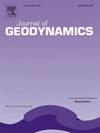利用多时InSAR分析揭示2015年至2022年北大不里士断层沿线的地壳变形模式
IF 2.1
3区 地球科学
Q2 GEOCHEMISTRY & GEOPHYSICS
引用次数: 0
摘要
本文介绍了利用多时相 InSAR 分析识别伊朗西北部北大不里士断层周围地壳变形模式的综合研究。尽管该断层已有两个多世纪没有发生地震,但其古代地震活动历史悠久,地震重现间隔超过两个世纪。这使其极易在未来发生活动,并产生重大破坏性地震。然而,对北大不里士断层的变形模式进行提取和建模以确定其活跃区段的研究十分有限。本研究的主要目的是得出断层位移的总体趋势,并调查地壳异常运动的压力区域。研究结果表明,从 2015 年到 2022 年,断层中部和西北部周边地区的地壳每年向上移动约 2 至 10 毫米。相比之下,西北断层邻近地区以及大不里士县西北部、西部和西南部地区的地面沉降速率约为每年 5 至 40 毫米。这些发现与从断层周围一些 IPGN 站获得的全球导航卫星系统视线测量结果一致,其 RMSE 为 1.72 毫米/年。此外,研究还确定了断层附近的临界点,这些临界点随着时间的推移呈现出不同的位移模式,表明地下环境中存在巨大的应变和显著的应力。根据对已确定临界点地壳运动时间序列数据的分析,发现断层带内地壳的主要运动模式基本符合正弦下降模式。此外,据观测,最近在断层西北部附近发生的地震就发生在这些临界点附近。该研究利用在这些临界点获取的视线(LOS)数据,估算出滑动速率为 7.71 ± 0.01 毫米/年,锁定深度为 11.27 ± 0.01 千米,从而有助于更好地了解该断层的致震行为。这些发现为了解北大不里士断层周围的地壳变形模式提供了宝贵的见解,突出了活跃地段和受压区域。本文章由计算机程序翻译,如有差异,请以英文原文为准。
Unveiling crustal deformation patterns along the north Tabriz fault from 2015 to 2022 using multi-temporal InSAR analysis
This paper presents a comprehensive study on the recognition of crustal deformation patterns surrounding the North Tabriz Fault in Northwestern Iran, utilizing Multi-Temporal InSAR analysis. The fault, despite its seismic inactivity for over two centuries, has a long history of ancient seismicity, with earthquake recurrence intervals exceeding two centuries. This makes it highly susceptible to future activity and the generation of significant and devastating earthquakes. However, limited research has been conducted on extracting and modeling deformation patterns of the North Tabriz Fault to identify its active segments. The primary objective of this study is to derive a general trend for fault displacement and investigate regions under pressure in terms of abnormal crustal movements. The results indicate that the Earth's crust in the surrounding regions of the central and northwest segments of the fault exhibits an upward movement ranging from approximately 2 to 10 millimeters per year from 2015 to 2022. In contrast, neighboring areas of the northwestern fault, as well as the northwestern, western, and southwestern parts of Tabriz County, experience ground subsidence with rates ranging from approximately 5 to 40 millimeters per year. These findings are consistent with GNSS-derived line-of-sight measurements obtained from some IPGN stations around the fault with an RMSE of 1.72 mm/yr. Furthermore, the study identifies critical points near the fault that exhibit varying and diverse displacement patterns over time, suggesting significant strain and notable stress within the subsurface environment. According to the analysis of time series data on crustal movements at the identified critical points, it has been found that the prevailing motion pattern of the Earth's crust within the fault zone largely conforms to a sinusoidal descending pattern. Additionally, recent earthquakes in the northwest vicinity of the fault have been observed to occur close to these critical points. Using line-of-sight (LOS) data acquired at these critical points, the study estimates a slip rate of 7.71 ± 0.01 mm/year and a locking depth of 11.27 ± 0.01 km, contributing to a better understanding of the fault's seismogenic behavior. These findings provide valuable insights into the crustal deformation patterns around the North Tabriz Fault, highlighting active segments and regions under pressure.
求助全文
通过发布文献求助,成功后即可免费获取论文全文。
去求助
来源期刊

Journal of Geodynamics
地学-地球化学与地球物理
CiteScore
4.60
自引率
0.00%
发文量
21
审稿时长
6-12 weeks
期刊介绍:
The Journal of Geodynamics is an international and interdisciplinary forum for the publication of results and discussions of solid earth research in geodetic, geophysical, geological and geochemical geodynamics, with special emphasis on the large scale processes involved.
 求助内容:
求助内容: 应助结果提醒方式:
应助结果提醒方式:


